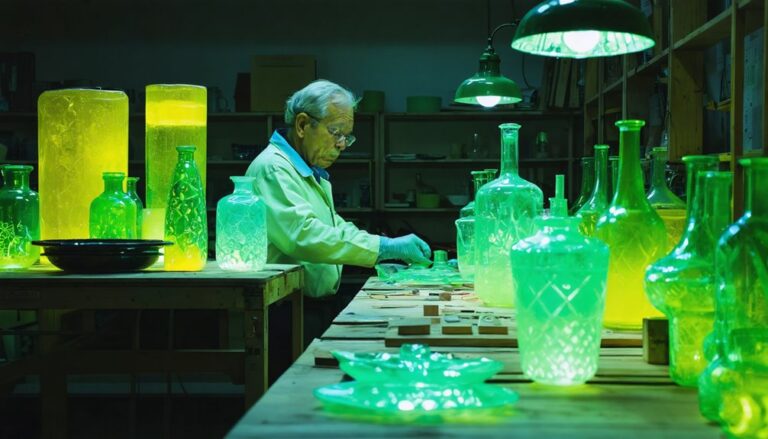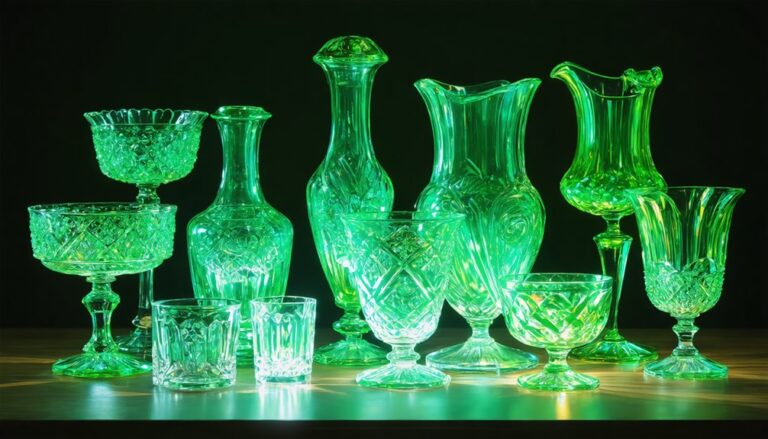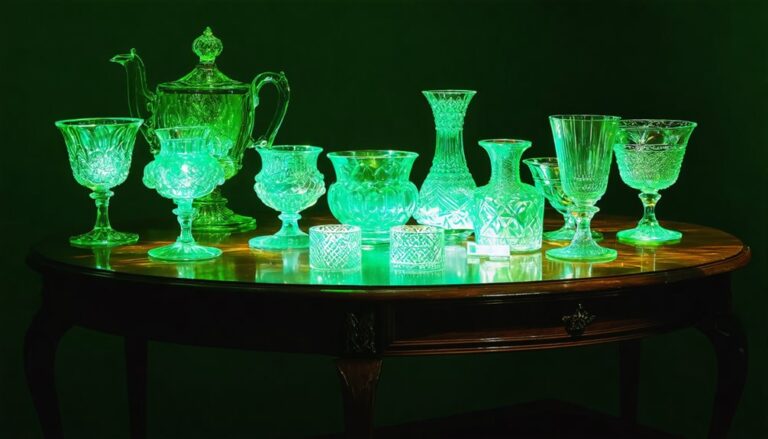Cultural Significance of Uranium Glass in Early 20th Century
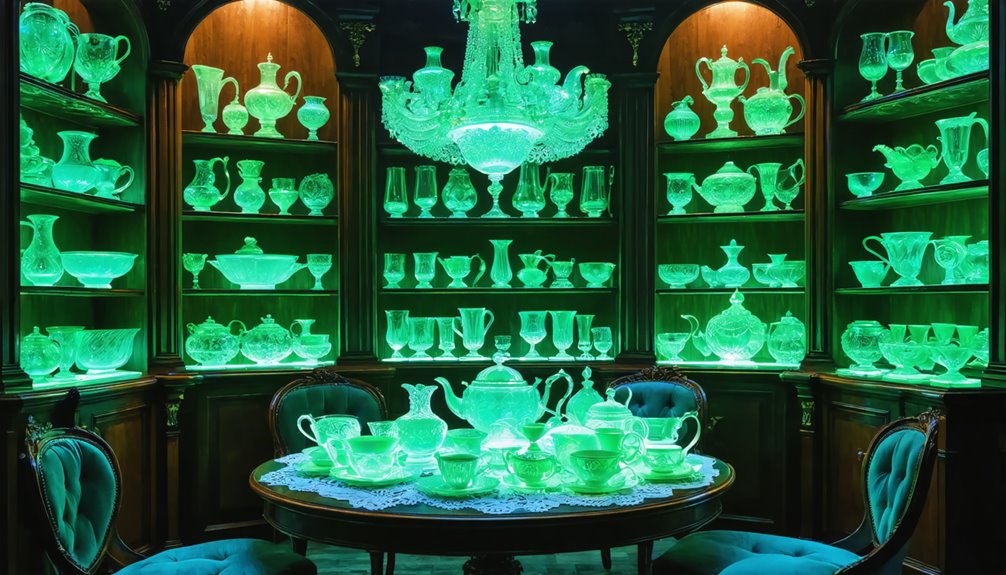
Uranium glass gained popularity in the early 20th century. It was a time when society was excited about science and progress. The glass had a striking yellow-green color that came from adding uranium oxide. This unique glow caught people’s attention. It became a favorite in Art Nouveau and Art Deco styles, which represented modernity and creativity.
People were fascinated by its fluorescence. It sparked interest in science and culture. Many collectors sought out uranium glass for its beauty and rarity. However, World War II changed everything. Wartime restrictions on uranium impacted its production. As a result, the perception of uranium glass shifted, and it became less common.
Exploring uranium glass gives us a glimpse into the cultural trends of the early 20th century. It reflects the excitement of the time and the blend of art with scientific discovery. This glassware tells a story of innovation, curiosity, and the impact of historical events on everyday items.
Key Takeaways
Uranium glass marked a vibrant era of modernity and scientific progress in the early 20th century. This unique glass, known for its bright green hue and fluorescent glow, became a symbol of innovation in many households. It was displayed at significant events such as the 1900 Exposition Universelle, where its captivating luminescence under ultraviolet light fascinated many.
Artists during this time were inspired by uranium glass. Movements like Art Nouveau and Art Deco embraced its striking appearance, using it to enhance their creative works. The glass became a popular decorative item, showcasing the blend of science and art.
People were curious about the radioactive properties of uranium glass. This curiosity sparked conversations about science and safety in everyday life. It was a time when science was viewed with excitement and wonder.
However, after World War II, views on uranium glass shifted. Concerns about nuclear safety and the risks associated with radiation changed how society saw this once-popular item. What was once a common household object became more of a niche collectible. Today, uranium glass is appreciated by collectors who recognize its historical significance and unique beauty.
Victorian Era’s Fascination With Uranium Glass
During the Victorian Era, homes brimmed with exquisite decorations. One standout trend was uranium glass, often known as “Vaseline glass” because of its unique yellow-green hue. This glass captivated Victorians with its beauty and its ability to glow under ultraviolet light.
Manufacturers like Whitefriars Glass produced a wide array of decorative items. They crafted elegant tableware, ornate vases, and other artistic pieces that caught the public’s eye. People displayed these luminous objects proudly in their homes.
Uranium glass wasn’t just pretty; it held deeper cultural meaning. It represented a blend of art and science, showcasing the innovative spirit of the time.
Owning these radiant pieces connected Victorians to nature’s hidden marvels and to the skilled craftsmanship of their era. This fascination with uranium glass reflected a broader curiosity about scientific discoveries during that period.
Symbolism of Modernity and Innovation
Uranium glass has a rich history that reflects the excitement of the late 19th and early 20th centuries. This unique glass, also known as Vaseline glass, was created by adding uranium oxides to the glass mixture. The result was a strikingly vibrant glow when exposed to UV light. People were captivated by this brilliant fluorescence, seeing it as a symbol of the scientific breakthroughs of the time.
Early uses of uranium glass went beyond mere decoration. It was incorporated into everyday items, from tableware to decorative pieces. Collectors and regular consumers alike were drawn to its charm. Owning uranium glass was a way to connect with the modern age, where science and art merged seamlessly. This glass signified more than just a product; it represented a cultural shift towards embracing new technologies.
The popularity of uranium glass was fueled by the optimism surrounding scientific discovery. As chemists and glassmakers experimented, they produced items that showcased both beauty and innovation. Each piece of uranium glass served as a reminder of the potential that lay within scientific advancements. Its legacy continues today, symbolizing a time when people eagerly looked forward to the future.
Uranium Glass in Domestic Décor
In a Victorian-era home, uranium glass stands out. Its soft yellow-green glow captures attention on shelves, tables, and mantelpieces. Commonly called Vaseline glass, this unique material gained popularity in the early 20th century. Families displayed it as a sign of admiration for science and progress. The glass is fascinating because it glows brightly under ultraviolet light, adding to its charm.
Uranium glass, glowing gently under ultraviolet light, symbolized Victorian families’ fascination with science and the optimism of a new era.
Manufacturers like Fenton created a range of items from uranium glass. Their products included both decorative and practical pieces. These items were affordable and became cherished fixtures in many Victorian homes.
People often used uranium glass in various household settings. Dining tables featured plates and compotes, adding a touch of elegance. In kitchens, measuring cups and mixing bowls made cooking more exciting. Living rooms showcased vases and decorative ornaments, enhancing the aesthetic appeal. Mantelpieces displayed figurines and mantle clocks, serving as conversation starters. Cabinets held tea sets and goblets, making gatherings more special.
Uranium glass reflects a time when design and science intertwined. Its vibrant glow not only served a decorative purpose but also symbolized the optimism of the era. As families embraced new materials, uranium glass became a beloved part of their everyday lives.
Influence on Art Nouveau and Art Deco Designs
Uranium glass, known for its striking greenish-yellow color, has a fascinating history. In the late 19th century, during the Art Nouveau movement, artists and craftsmen embraced this unique material. The glass had a radiant glow, which made it a perfect match for the era’s love of nature and organic forms. Designers created delicate vases and beautiful tableware, utilizing uranium glass to enhance the natural beauty of their pieces.
As time moved on, the Art Deco period emerged in the 1920s and 1930s. This new style celebrated bold lines and geometric shapes. Glassmakers like Frederick Carder and the Fenton Art Glass Company took a liking to uranium glass. Its vibrant colors and ability to catch light made it highly sought after. Chandeliers and decorative items crafted from uranium glass became symbols of modern design.
The use of uranium glass during these two artistic movements shows how materials can reflect cultural and scientific progress. It brought people together, creating trends that were popular in homes and businesses alike.
The history of uranium glass highlights its importance in the world of art and design.
Scientific Curiosity and Public Interest
In the 19th century, scientists discovered uranium glass. Its unique glow fascinated both researchers and the general public. This interest led to many scientific investigations. During the Victorian era, uranium glass became a symbol of innovation and progress. Society was captivated by new technologies and ideas.
The intriguing fluorescent qualities of uranium glass caught even more attention in the 1930s. When exposed to black lights, its glow was mesmerizing. People began to display uranium glass at parties and gatherings. This shared enthusiasm for science created a sense of community.
Scientists recognized the potential of uranium glass as a teaching tool. It helped explain complex ideas about radioactivity in a way that was easy to understand. This made science more accessible to everyone.
| Aspect | Cultural Impact |
|---|---|
| Scientific Curiosity | Encouraged public exploration of science |
| Educational Use | Simplified concepts of radioactivity |
| Social Connection | Created excitement and a sense of belonging |
Uranium glass not only sparked scientific curiosity but also brought people together. The blend of science and social interaction made it a notable part of history.
Role of Uranium Glass in Consumerism Expansion
Uranium glass began as more than just a scientific oddity. It quickly caught the attention of everyday people, changing how they thought about home goods. In the Victorian and Edwardian eras, the production of uranium glass boomed. People wanted stylish items that blended beauty with new technology. Manufacturers like Fenton and Whitefriars tapped into this desire, crafting decorative pieces and tableware that appealed to the growing middle class.
Uranium glass transformed Victorian homes, merging elegant design and innovative technology into sought-after decorative pieces for the rising middle class.
The introduction of black light technology added to the excitement. This innovation made the unique fluorescence of uranium glass come alive. It became a sought-after novelty item. Homeowners loved showing off this striking glassware, which represented modernity and connected them to the rapid advancements of the time. In a way, it brought the fascinating blend of art and science right into their living rooms.
Uranium glass also had practical uses. It wasn’t just pretty; it was used in everyday items like bowls and vases. This combination of utility and aesthetic drew in consumers who wanted to embrace the modern age.
The rise of uranium glass reflects a broader trend in consumerism, where people began to value both style and innovation in their homes.
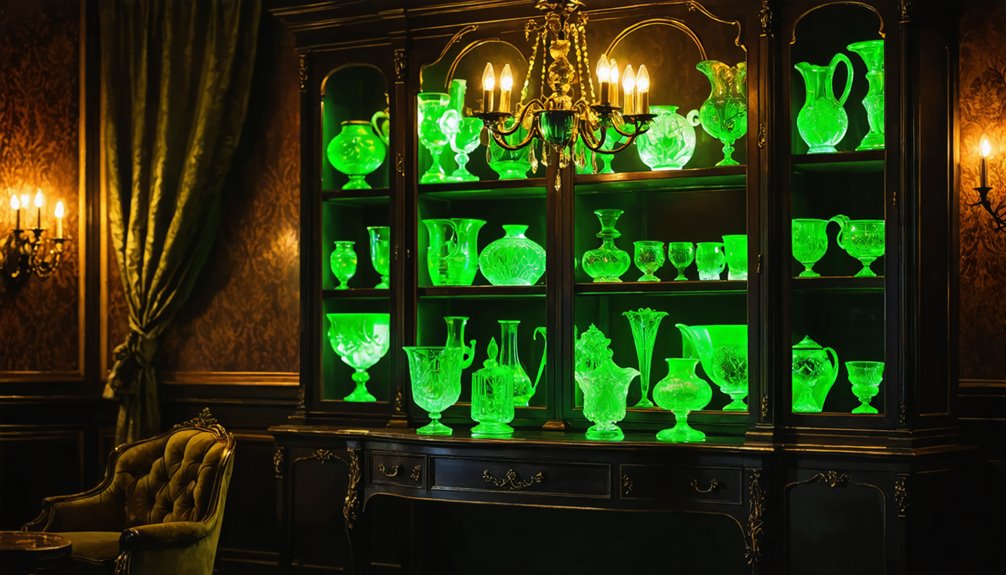
Societal Perceptions of Uranium Glass Safety
Have you ever thought about why uranium glass was once seen as perfectly safe? In the early 1900s, people viewed uranium glass differently than we do now. Back then, there wasn’t much knowledge about the health risks related to radioactive materials. Many saw these glowing items as symbols of progress and modern living. They believed that the radioactivity was so low that it wouldn’t harm them.
Research conducted during that time reassured the public. Studies concluded that using uranium glass wasn’t a significant health threat. This lack of concern made it popular in homes. People enjoyed its unique glow and vibrant colors, often using it for decorative purposes.
Things changed after World War II when the nuclear age began. As awareness about radiation grew, so did caution regarding uranium glass. Safety regulations started to emerge. Yet, the captivating glow of uranium glass still fascinated many. The beauty of these items often overshadowed the concerns about their safety.
Today, we’ve a better understanding of radioactivity and its potential effects on health. While uranium glass can still be collected and admired, its history reminds us of how societal views on safety can evolve over time.
Marketing Patterns and Sales Strategies
Uranium glass has a rich history that dates back to the 1830s. Manufacturers recognized early on that this unique glass could captivate consumers. Its vibrant colors and striking glow under black light made it a novelty item. Companies like Fenton and Whitefriars Glass played a key role in promoting uranium glass. They didn’t just create beautiful art pieces; they also produced practical tableware.
Since the 1830s, companies like Fenton and Whitefriars Glass have made uranium glass popular through vibrant colors and functional tableware pieces.
This approach widened the audience for uranium glass. It appealed to both wealthy collectors and everyday families. The advertisements of that time were bold and eye-catching. They highlighted the glass’s fluorescent properties, showcasing it as a modern innovation. This marketing strategy created a sense of belonging among buyers. People who loved unique home decor found a connection with uranium glass.
The early uses of uranium glass weren’t limited to decoration. It was also valued for its functionality. The blend of beauty and practicality helped it gain popularity. Over time, uranium glass became a symbol of modernity, reflecting the scientific advancements of the era.
Its legacy continues to fascinate collectors and enthusiasts today.
Uranium Glass in Exhibition and World’s Fairs
Uranium glass has a fascinating history. It was first made in the early 19th century. People used it for various purposes, including tableware and decorative items. The glass had a unique quality. Under ultraviolet light, it would glow with a vibrant green color. This glow attracted attention.
Exhibitions and world’s fairs played a big role in popularizing uranium glass. At the 1851 Great Exhibition in London, visitors were amazed by its beauty. The glass represented modern science and innovation.
In Paris’s 1900 Exposition Universelle, the glow of uranium glass caught the eyes of many. It was more than just a pretty object; it symbolized progress in technology.
These events helped educate the public about uranium glass. People learned that it was safe to use. This knowledge eased fears about radiation.
As a result, collectors and enthusiasts began to appreciate uranium glass even more. It became a sought-after item for those who loved unique and artistic pieces. The combination of science and art made uranium glass a standout in history.
Dazzling Fair Exhibits
One fascinating chapter in the history of uranium glass involves its eye-catching displays at exhibitions and World’s Fairs in the late 1800s and early 1900s. During this time, people were captivated by uranium glass.
At the 1900 Exposition Universelle in Paris, artists presented beautifully crafted tableware and vases. These pieces not only showcased artistic skill but also glowed impressively under ultraviolet light. This unique characteristic drew significant attention.
By the early 20th century, these exhibitions sparked a surge of consumer interest. Manufacturers responded by increasing the production of uranium glass items.
The 1939 New York World’s Fair took this even further. It highlighted advancements in glassmaking, attracting fairgoers with glowing uranium glass in various decorative styles. This event seamlessly blended creativity with technological innovation, making it a remarkable display of the era’s artistic and scientific achievements.
Symbol of Modern Science
Uranium glass, often called Vaseline glass, became a fascinating symbol of early scientific exploration. This unique glass, which contains a small amount of uranium, offered a glimpse into the wonders of modern science. It caught the eye of many at exhibitions and World’s Fairs during the late 19th and early 20th centuries.
Events like the Philadelphia’s 1876 Centennial Exposition and Chicago’s 1893 World’s Columbian Exposition celebrated innovation. At these exhibitions, manufacturers such as Fenton Glass showcased uranium glass with great enthusiasm. They highlighted its striking colors and captivating glow under ultraviolet light.
This glass wasn’t just a decorative item; it represented a blend of artistry and scientific progress. Visitors were drawn to the radiant displays, eager to witness the beauty of this new material. Intricate glass sculptures demonstrated the creativity and technical skill of the makers.
Spectators gathered, captivated by the luminous exhibits. The fascination with uranium glass wasn’t just about its appearance; it was about the excitement of the scientific advancements of the time. It marked a period where art, science, and society intertwined, reflecting a collective passion for innovation.
Collectors and Early Enthusiasts of Uranium Glass
Uranium glass has fascinated people for many years. Early collectors played a vital role in highlighting this unique material. In the early 1900s, these collectors were attracted to uranium glass because of its striking fluorescence. Under ultraviolet light, everyday items transformed into stunning displays of color and light.
Prominent figures like Dan and Lisa Sawyers became well-known for their extensive collections. They showcased the artistic and historical importance of these glowing pieces. Their efforts inspired others to see the beauty in uranium glass.
Enthusiast groups, such as Vaseline Glass Collectors, Inc., emerged to support this growing interest. Co-founder Dave Peterson helped create a friendly community where people could share knowledge, appreciation, and preservation techniques. This collaboration fostered a sense of belonging among uranium glass lovers that still thrives today.
Uranium glass wasn’t just a collector’s item. In the past, it was used in everyday household items like dishes and decorative objects. Its radioactive properties were known, but safety concerns were less understood at the time. Collectors sought these pieces not only for their beauty but also for their unique history.
Cultural Representations in Early 20th Century Media
Uranium glass emerged in the late 19th and early 20th centuries as a novel material that captured the public’s imagination. People were fascinated by its unique properties, especially its vibrant fluorescence under ultraviolet light. This glowing effect made it a popular choice in various entertainment settings, from theaters to nightclubs.
In homes, uranium glass was more than just functional. It represented luxury and status. Elegant vases glowed softly in parlors, creating an enchanting atmosphere. Nightclubs used luminous glassware to enhance performances, captivating audiences with their radiant beauty. Jewelry made from uranium glass also dazzled on stage, showcasing the material’s striking brilliance.
These early uses of uranium glass reflected a broader cultural trend. Society was eager to embrace modernity and scientific advancements. The allure of new materials, like uranium glass, symbolized innovation and sophistication.
It became a significant part of social gatherings, connecting people through shared experiences of wonder and excitement.
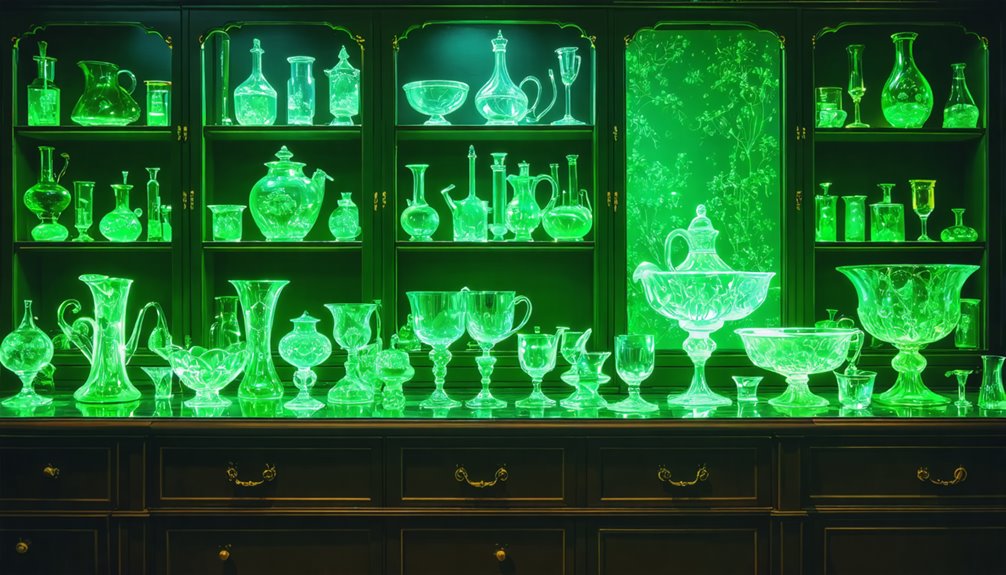
Impact of Wartime Restrictions on Cultural Trends
As World War II escalated, the availability of uranium glass took a significant hit. The U.S. government needed uranium for the Manhattan Project, which meant there wasn’t enough left for making glass. This change altered how people viewed uranium itself. It was no longer just a unique material; it became linked to nuclear danger and the horrors of war.
After the war, restrictions on uranium remained tight. Many glassmakers had to stop making uranium glass altogether or switch to using depleted uranium. This new material lacked some of the appeal that the original uranium glass had. Still, the glass glowed under ultraviolet light, which kept a small but dedicated group of collectors interested. These collectors were often drawn to the nostalgia and the unique beauty of uranium glass.
However, by the 1950s, public fear about nuclear energy pushed uranium glass out of mainstream use. It became more of a specialty item for collectors rather than a common decoration in homes. The cultural landscape around uranium glass shifted from everyday use to a niche interest, reflecting broader societal anxieties about nuclear power and safety.
Frequently Asked Questions
What Is the Significance of Uranium Glass?
Uranium glass is truly captivating. It offers a range of colors, from vibrant greens to soft yellows, thanks to the uranium content. This glassware has a rich history that dates back to the early 19th century. Initially, it was used to create decorative items and tableware. People appreciated its unique glow under ultraviolet light, which made it stand out.
During the Victorian era, uranium glass became popular. Manufacturers would add uranium to glass to enhance its appearance. This practice was not just for beauty; it was also a way to create items that caught the eye. The glass was often found in homes as elegant vases, dishes, and even jewelry. Collectors today still seek out these pieces because of their artistic designs and historical significance.
While the aesthetic appeal is undeniable, it’s important to consider the safety aspects. Uranium glass contains low levels of radioactivity. Handling these items requires some caution, especially if they are displayed in homes. It’s wise to keep them away from direct sunlight to prevent any potential leaching of uranium.
Why Do People Thrift for Uranium Glass?
Uranium glass has a fascinating history. It dates back to the early 19th century when scientists discovered that uranium could be used to create unique glassware. This glass glows under ultraviolet light due to the radioactive properties of uranium.
In the late 1800s, uranium glass became popular. It was used to make tableware and decorative items. People loved its vibrant colors and the way it caught the light. Manufacturers saw an opportunity and began producing it in large quantities. The glass was affordable, making it accessible to many families.
During World War II, the demand for uranium increased for military purposes. This affected the production of uranium glass. After the war, interest in the glass waned. However, it saw a revival in the 1980s when collectors began to appreciate its historical value.
Today, many people thrift for uranium glass. It’s not just about finding a unique piece; it’s also about connecting with history. Collectors enjoy the thrill of hunting for these vintage items. They appreciate the artistry and craftsmanship that went into making them. Plus, the eco-friendly aspect of reusing these materials adds to their charm.
Uranium glass pieces often tell stories of the past. Each item reflects a moment in time when glassmaking was both an art and a science. Collectors cherish these artifacts, preserving a slice of history for future generations.
Why Is Uranium Glass Valuable Today?
Uranium glass has a fascinating history that adds to its value today. Initially, it was created in the 1830s. Manufacturers used uranium to give glass a unique green or yellow glow under UV light. This glow comes from the uranium itself, which is a radioactive element.
In the early 20th century, uranium glass became popular in households. Many people appreciated its beauty and the way it caught light. It was often used for tableware, decorative pieces, and even in chandeliers. The glassware was seen as modern and stylish.
Collectors today find uranium glass appealing for its artistic qualities. The glow under UV light is intriguing and adds a magical touch to displays. While there are some concerns about the mild toxicity of uranium, the amounts in glass are generally considered safe.
The history of uranium glass connects to vintage trends. Many collectors love the nostalgia it brings. It represents a unique blend of art, science, and history. Overall, its early uses and captivating properties make uranium glass a valuable collectible today.
Why Was Uranium Glass Banned?
Uranium glass has an interesting history. Early in the 20th century, it was popular for its vibrant green color and ability to glow under ultraviolet light. Manufacturers used uranium as a colorant in glass, making it attractive and unique.
However, as people learned more about the dangers of radioactive materials, safety regulations became stricter. Concerns about health risks led to a decline in its popularity. In the 1950s and 1960s, many glassmakers stopped producing uranium glass.
Today, this historical context has sparked a renewed interest among collectors. Many appreciate the artistry and rarity of uranium glass. The strong market demand reflects a fascination with its past and an interest in its scientific properties. Collectors enjoy connecting with a unique piece of history that combines beauty and science.
Conclusion
Uranium glass has a fascinating history that reflects the spirit of innovation in the early 20th century. At the 1904 St. Louis World’s Fair, over 10,000 items made from uranium glass lit up the exhibits. This event showcased how much people were drawn to new materials and designs. The bright, glowing pieces were a symbol of progress and creativity during that time.
Wartime restrictions later changed everything. These limits affected the production and use of uranium glass. As a result, the vibrant trend faded. This shift illustrates how art, home décor, and collectibles often respond to larger historical events.
Today, uranium glass is still highly valued by collectors. These striking artifacts tell us stories about societal fascination with science and creativity in the past. Each piece shines a light on a unique chapter of our cultural heritage.
